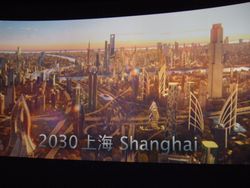Nationalism, Boosterism, and World's Fairs
Writing on my Facebook page, Reason's Shikha Dalmia recalls her own May visit to the Shanghai Expo, along with some local Chinese.
They were terribly disappointed with the US exhibit and regarded its lack of seriousness almost as a slap on the face. They were really moved by the dazzling Chinese pavilion -- which suggested to me that the real reason Chinese authorities have spent $60 billion on such a white elephant, in addition to what you mention, is to keep alive a spirit of nationalism.
The U.S. pavilion, which looks like a prefab movie theater and whose main feature is the filmic equivalent of a guidance counselor poster, is famously lame. But the Chinese misunderstand why. It's not a slap at China. It's a slap at world's fairs. On a positive note, it features great, improvised performances by bilingual U.S. college students, who do things like teach the Chinese crowd to shout, "YOU...ARE...AWESOME."
Shikha's comment gives me an excuse to resurrect some material that didn't make it into my final column. An earlier draft included the following observation on the boosterism of world's fairs:
It gives visitors the same thrill Sam Hyde, a bookkeeper from Belleville, Illinois, felt upon entering the 1904 St. Louis World's Fair: the feeling "that the whole world [is] there and every nation [is] showing its best products and doing its best to please."
Here is the most peculiar aspect of world's fairs. As classic tools for city and national boosters, they combine openness to the world with a sense of (often-defensive) local superiority: We are the center of civilization, our culture its standard; that's why everyone's here. The foreign exhibits simultaneously validate the host's importance and provide a sort of petting zoo of exotic cultures. Remembering his 1904 visit, Sam Hyde noted the popularity of the Filipino military band, praising the "extraordinary talent of those little brown fellows." Today's readers cringe at his language, but the point of the sentiment is appreciation, not difference. Exoticism provides a bridge to empathy. But the locals still determine the standard of value.
That's psychologically realistic. The official ideology of international expositions may stress common humanity, but one thing human beings have in common is the tendency to divide the world between our group and others. The Chinese want to celebrate China, and Chinese fairgoers really do view all those foreigners as foreign. The deception lies in the way international expositions gloss over conflicts, portraying a world as harmonious as the International House of Pancakes. (Both "Bel-Gem waffles" and Disney's "It's a Small World" were hits in 1964.) In Shanghai, irony-minded westerners head for the North Korean and Iranian pavilions, conveniently located next to each other on the unofficial axis of evil.
And here's a photo:

